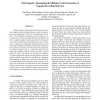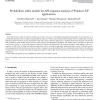26 search results - page 2 / 6 » A Hybrid Model to Detect Malicious Executables |
SAC
2010
ACM
14 years 1 months ago
2010
ACM
Hosts infected with malicious software, so called malware, are ubiquitous in today’s computer networks. The means whereby malware can infiltrate a network are manifold and rang...
CMS
2010
13 years 7 months ago
2010
While conventional malware detection approaches increasingly fail, modern heuristic strategies often perform dynamically, which is not possible in many applications due to related ...
DIMVA
2011
12 years 10 months ago
2011
Abstract. High-interaction honeyclients are the tools of choice to detect malicious web pages that launch drive-by-download attacks. Unfortunately, the approach used by these tools...
ACSAC
2006
IEEE
14 years 28 days ago
2006
IEEE
Modern malware often hide the malicious portion of their program code by making it appear as data at compiletime and transforming it back into executable code at runtime. This obf...
PR
2008
13 years 6 months ago
2008
Given the pervasive nature of malicious mobile code (viruses, worms, etc.), developing statistical/structural models of code execution is of considerable importance. We investigat...


